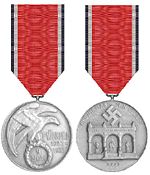
Blood Order
Encyclopedia

Beer Hall Putsch
The Beer Hall Putsch was a failed attempt at revolution that occurred between the evening of 8 November and the early afternoon of 9 November 1923, when Nazi Party leader Adolf Hitler, Generalquartiermeister Erich Ludendorff, and other heads of the Kampfbund unsuccessfully tried to seize power...
) of 9 November 1923 (Ger. Medaille zur Erinnerung an den 9. November 1923), was one of the most prestigious decorations in the Nazi Party. Instituted in March 1934, the medal is solid silver, with the obverse bearing a depiction of an eagle with a wreath in its talons, with the date 9.Nov. within the wreath and the inscription München 1923-1933 to the right. The reverse bears a picture of the Feldherrnhalle
Feldherrnhalle
The Feldherrnhalle is a monumental loggia in Munich, Germany. It was built between 1841 and 1844 at the southern end of Munich's Ludwigstrasse next to the Palais Preysing and east of the Hofgarten. Previously the Gothic Schwabinger Tor occupied that place...
in Munich (where the coup ended in defeat), a swastika
Swastika
The swastika is an equilateral cross with its arms bent at right angles, in either right-facing form in counter clock motion or its mirrored left-facing form in clock motion. Earliest archaeological evidence of swastika-shaped ornaments dates back to the Indus Valley Civilization of Ancient...
and the inscription: UND IHR HABT DOCH GESIEGT ("...and you were victorious after all").

Erich Ludendorff
Erich Friedrich Wilhelm Ludendorff was a German general, victor of Liège and of the Battle of Tannenberg...
. All medals were numbered (except Hitler's and Göring's) and awarding was done very carefully. Unlike other medals, the ribbon was worn on the right breast of the uniform tunic in the form of a rosette.
In May 1938, to the dismay of the putsch participants, the award was extended to persons who had (a) served time in prison for Nazi activities before 1933, (b) received a death sentence which was later commuted to life imprisonment for Nazi activities before 1933, or (c) been severely wounded in the service of the Party before 1933; subsequently it was further extended to members of the Austrian Nazi Party who had participated in the 1934 February Uprising or July Putsch
July Putsch
The July Putsch was a failed coup d'etat attempt against the Austrofascist regime by Austrian Nazis, which took place between 25 – 30 July 1934.- Background :...
, or who had received significant prison time or injuries for National Socialist activities. It could also be bestowed on certain other individuals at the discretion of Adolf Hitler
Adolf Hitler
Adolf Hitler was an Austrian-born German politician and the leader of the National Socialist German Workers Party , commonly referred to as the Nazi Party). He was Chancellor of Germany from 1933 to 1945, and head of state from 1934 to 1945...
, the last recipient being Reinhard Heydrich
Reinhard Heydrich
Reinhard Tristan Eugen Heydrich , also known as The Hangman, was a high-ranking German Nazi official.He was SS-Obergruppenführer and General der Polizei, chief of the Reich Main Security Office and Stellvertretender Reichsprotektor of Bohemia and Moravia...
(posthumous). These subsequent medals were struck in 80% silver with serial numbers above 1500 and did not carry the maker's name (J. FUESS MÜNCHEN) as the Type I medals did.
If a holder of this medal left the party, the medal would have to be relinquished.
Two women received this award (one putsch participant and one posthumous outstanding service). Given the number of original marchers in the putsch, the number of posthumous awards given under the 1938 extensions (436), and the awards for outstanding service under those same extensions, the total number of recipients numbered less than 6,000.

